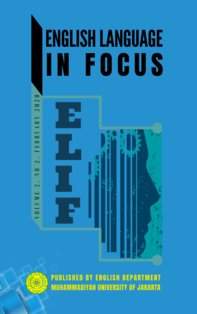Group Investigation (GI) on Students Descriptive Writing
DOI:
https://doi.org/10.24853/elif.2.2.103-110Keywords:
Group Investigation, descriptive writing, teaching writing.Abstract
The objective of this study was to investigate whether Group Investigation increased first-grade students’ descriptive writing at Raman Siriwit Junior High School, Thailand. This study is quantitative were pre-test and post-test used to collect the data. The writers applied a t-test to analyze the data. Based on the Equal variance column, in obtained t-count scores is 11.808 by computing table scores n1 + n1-2 = 23 + 23 - 2 = 44, then obtained t-table score is 2.05 and significant score is 0.000. Because the score of t-count is 11.808> t-table 2.05 and the significant score is 0.000 <α = 0.05, so that H0 is rejected and Ha is accepted. This means that the pretest writing score compared to the posttest writing score is different. This means that there are significant differences in writing pretest scores with posttest scores after the Group Investigation method. Group Investigation increased first-grade students’ descriptive writing at Raman Siriwit Junior High School, Thailand.References
Buscemi, S. V. (1990). A Reader for Developing Writers. New York: McGraw-HillCompanies, Inc.
Cowie, J. R. (1983). Automatic Analysis of Descriptive Texts. Proceedings of the First Conference on Applied Natural Language Processing, 123. https://doi.org/10.3115/974194.974218
Creswell, J. W. (2009). Research Design Qualitative, Quantitative, and Mixed Methods Approaches. London: SAGE Publications, Inc.
Elbow, P. (2006). Do We Need a Single Standard of Value for Institutional Assessment? An Essay Response to Asao Inoue’s “Community-Based Assessment Pedagogy.” Assessing Writing, 11(2), 81–99. https://doi.org/10.1016/j.asw.2006.07.003
Hadi, M. S., & Anggaira, A. S. (2017). The Use of Mobile Assisted Language Learning (MALL) In Teaching Writing. 15th Asia TEFL & 64th TEFLIN International Conference. Retrieved from https://www.academia.edu/36316786/Asia_TEFL_full_paper
Harmer, J. (2004). How to Teach Writing. New York: Longman.
Hyland, K. (2004). Genre and Second Language Writing. Ann Arbor, MI: The University of Michigan Press.
Jacobs, G. (2008). A Review of “Group Investigation and Student Learning: An Experiment in Singapore Schools.” International Research in Geographical and Environmental Education, 17(4), 372–375. https://doi.org/10.1080/10382040802401680
Kane, T. S. (2000). Essential Guide to Writing. Oxford.
Nystrand, M. (1989). A Social-Interactive Model of Writing. Written Communication, 6(1), 66–85. https://doi.org/10.1177/0741088389006001005
Randal, H. (2004). Literacy an Introduction. Edinburgh: Edinburgh University.
Rescue Writing. (2017). Writing Descriptive Text. Retrieved April 5, 2019, from https://rescuewriting.org/featured/writing-descriptive-text/
Richards, J. C., Hull, J., & Proctor, S. (2005). Interchange: English for international communication 1. Cambridge: Cambridge University Press.
Sharan, Y., & Sharan, S. (1990). Group Investigation Expands Cooperative Learning. Educational Leadership, 47(4), 17–21. Retrieved from https://eric.ed.gov/?id=EJ400492
Solomon, R. L., & Lessac, M. S. (1968). A Control Group Design for Experimental Studies of Developmental Processes. Psychological Bulletin, 70(3), 145–150. Retrieved from https://doi.org/10.1037/h0026147
Tuckman, B. W. (1965). Developmental Sequence in Small Groups 1. Psychological Bulletin, 63(6), 384–399.
Vesilind, P. A. (2007). Public Speaking and Technical Writing Skills for Engineering Students. USA: Lakeshore Press.
Your Dictionary. (2015). Descriptive Text Examples. Retrieved April 5, 2019, website: https://examples.yourdictionary.com/descriptive-text-examples.html
Zingaro, D. (2008). Group Investigation: Theory and Practice. Retrieved from http://www.danielzingaro.com/gi.pdf
Downloads
Published
Issue
Section
License
Authors who publish with this journal agree to the following terms:
- Authors retain copyright and grant the journal right of first publication with the work simultaneously licensed under a Creative Commons Attribution License that allows others to share the work with an acknowledgment of the work's authorship and initial publication in this journal.
- Authors can enter into separate, additional contractual arrangements for the non-exclusive distribution of the journal's published version of the work (e.g., post it to an institutional repository or publish it in a book), with an acknowledgment of its initial publication in this journal.
- Authors are permitted and encouraged to post their work online (e.g., in institutional repositories or on their website) before and during the submission process, as it can lead to productive exchanges, as well as earlier and greater citation of published work (See The Effect of Open Access).


